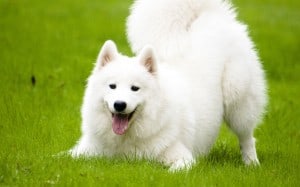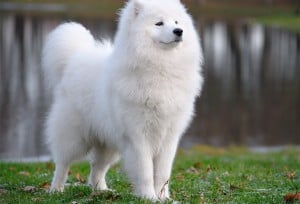
The Samoyed will do best in a household where they can receive as much love as they give. The Samoyed can sometimes be difficult to train because they are so intelligent and sometimes stubborn. If training begins at an early age and is done with consistency, patience and love the results can be most rewarding. Positive reinforcement is the key when training a Samoyed. In general, the Samoyed is a loyal and lovable family pet.

Some Samoyeds have blue eyes, which is a disqualification when exhibiting the dog. Samoyeds have deep chests and powerful legs and necks. They move quickly, but gracefully.The Samoyed has a very interesting history. Thousands of years ago, the Samoyed people of Iran migrated to Siberia. This tribe consisted of several families, and part of each family was their dog. The dogs were immensely useful in herding reindeer, pulling sleighs and warming up cold bodies on cold Siberian nights. The first non-Samoyed person to become aware of the dogs was Adam Brand, in 1696.
The Samoyed breed is one of the few that have remained pure since ancient times. While other breeds have strains of wolf and fox, the Samoyed has none. The first Samoyeds available to Europeans were those of Ernest Kilburn-Scott of England who placed an advertisement offering Samoyeds for sale in 1891. The first Samoyed in the American Kennel Club Stud Book, in 1906, was owned by Mercy d’Argenteau, Princess of Montyglyon.

Samoyeds are not strangers to hard work and need lots of exercise to keep them happy and healthy. They should be given brisk walks several times daily.The Samoyed, like many larger breeds, can have a tendency towards hip dysplasia. Because the Samoyed’s coat is so thick, fleas can also be a problem. Other common ailments associated with the Samoyed breed include hypothyroidism, Von Willebrand’s Disease, and retinal problems.
